Mental Model
July 29, 2025
6
Min
Mental Models for Corporate Teams: A Workshop Guide
Mental Model
|
Things slow down. Strategies stall. Friction builds under the surface.
We’ve seen it time and again - teams packed with talent still struggle to make clear, confident decisions. Not because they lack capability, but because they lack a shared thinking infrastructure. That’s where mental models come in.
This post is for leaders who want to embed mental models not just into their thinking, but into their team’s culture. The best part? You don’t need an offsite or a three-day retreat. With the right approach, you can run a powerful, engaging workshop in two hours or less.
Let’s walk you through how.
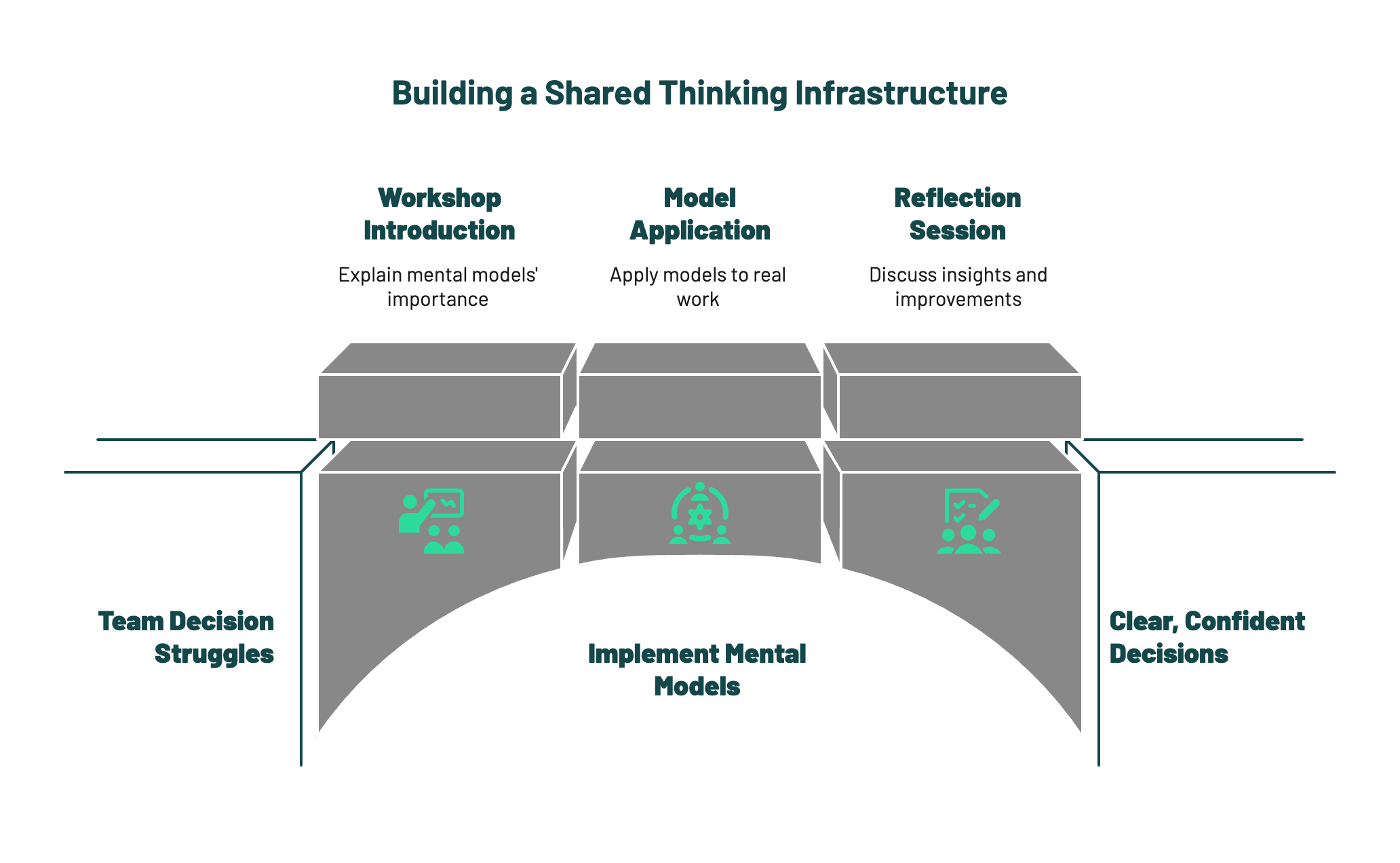
In a world where 70% of strategic failures are traced to execution breakdowns - not flawed vision - the way teams think together becomes a competitive advantage.
Mental models provide scaffolding for sharper decisions and smoother collaboration. As Charlie Munger put it:
“80 or 90 important models will carry about 90% of the freight in making you a worldly-wise person.”
We’ve found that even five to seven models - if consistently used across functions - can radically elevate how teams debate, prioritise, and problem-solve.
We use a 3-part design we call the BAR Method:
Let’s break it down.

Before models can work as mental shorthand, your team needs to know them - deeply enough to spot them in the wild.
Pick 3–5 models that fit your team’s domain. For example:
Activity:
Break the group into pairs. Each pair gets a one-pager with a model explanation and a famous or fictional example (e.g. Apple using First Principles, or Sherlock Holmes using Inversion). Pairs then teach the model back to the group in 2 minutes.
Reflection Prompt: What model here challenges your default approach to decision-making?
Micro-action: Add these models to team wikis or internal playbooks as living tools - not one-time slides.
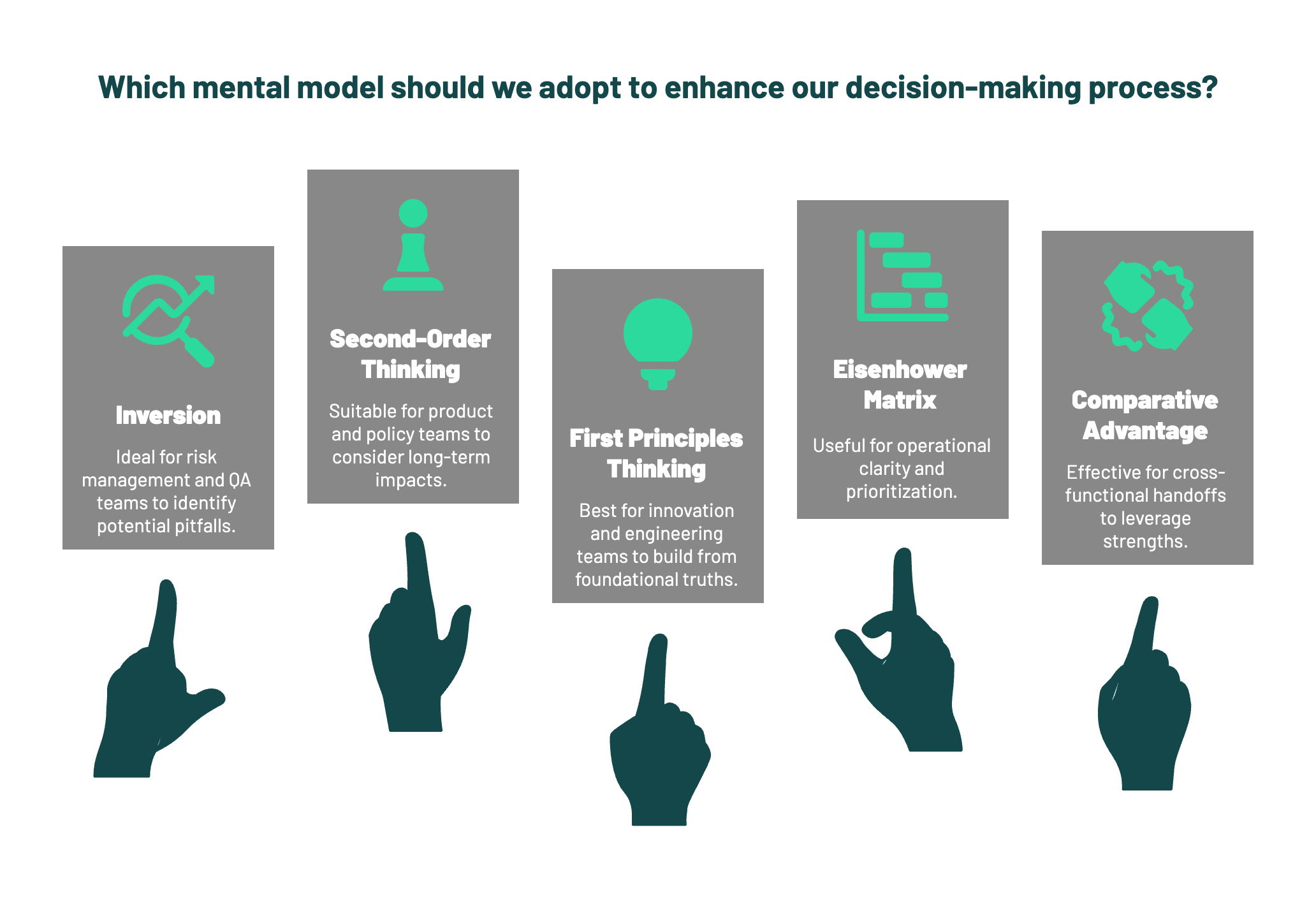
Models only stick when they solve something you actually care about.
Select a live challenge or recent decision the team made - product launch, market entry, hiring dilemma, pricing change. Then use a model to revisit or reframe it.
Example Scenario:
You’re evaluating two go-to-market plans. Use Second-Order Thinking to forecast not just the immediate outcome, but knock-on effects three steps out.
Facilitation Tip:
Give teams a simple worksheet:
Reflection Prompt: How did this model widen or deepen your original thinking?
Micro-action: Pick one upcoming team meeting where you’ll test-drive a model in real time.
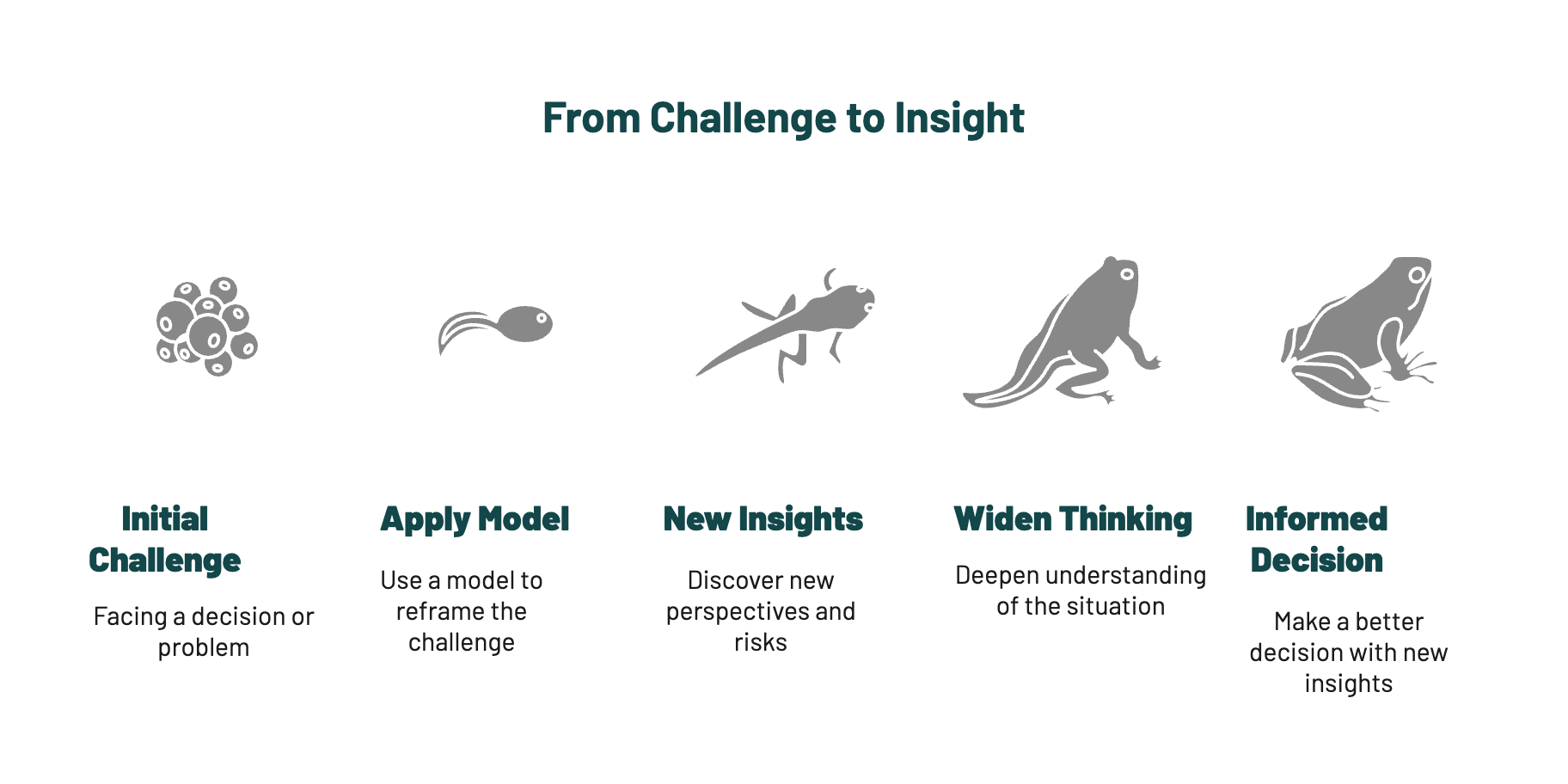
The aha moments often come after the workshop - if you make space for reflection.
Build a closing loop with these two components:
Optional Add-on:
Create a Slack or Teams thread called Mental Model in Action. Encourage people to post examples of when they caught themselves or others using a model.
Reflection Prompt: When did you last wish you'd used a model in hindsight?
Micro-action: Set a recurring 15-minute “Model Monday” slot where one person brings a model to apply to a team issue.
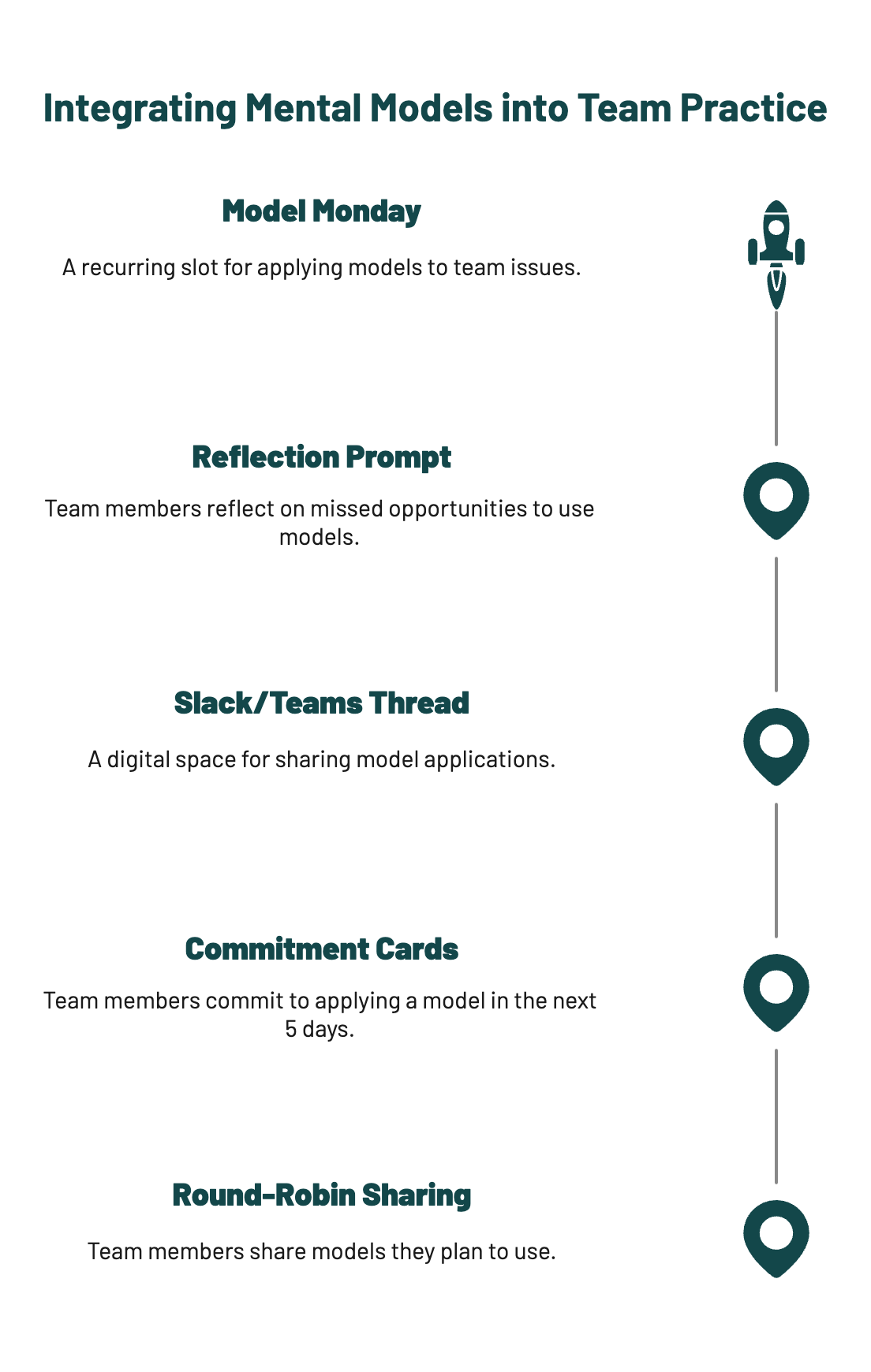
Pro Tip: Run the workshop with cross-functional groups. Diversity of roles reveals the true power of shared frameworks.
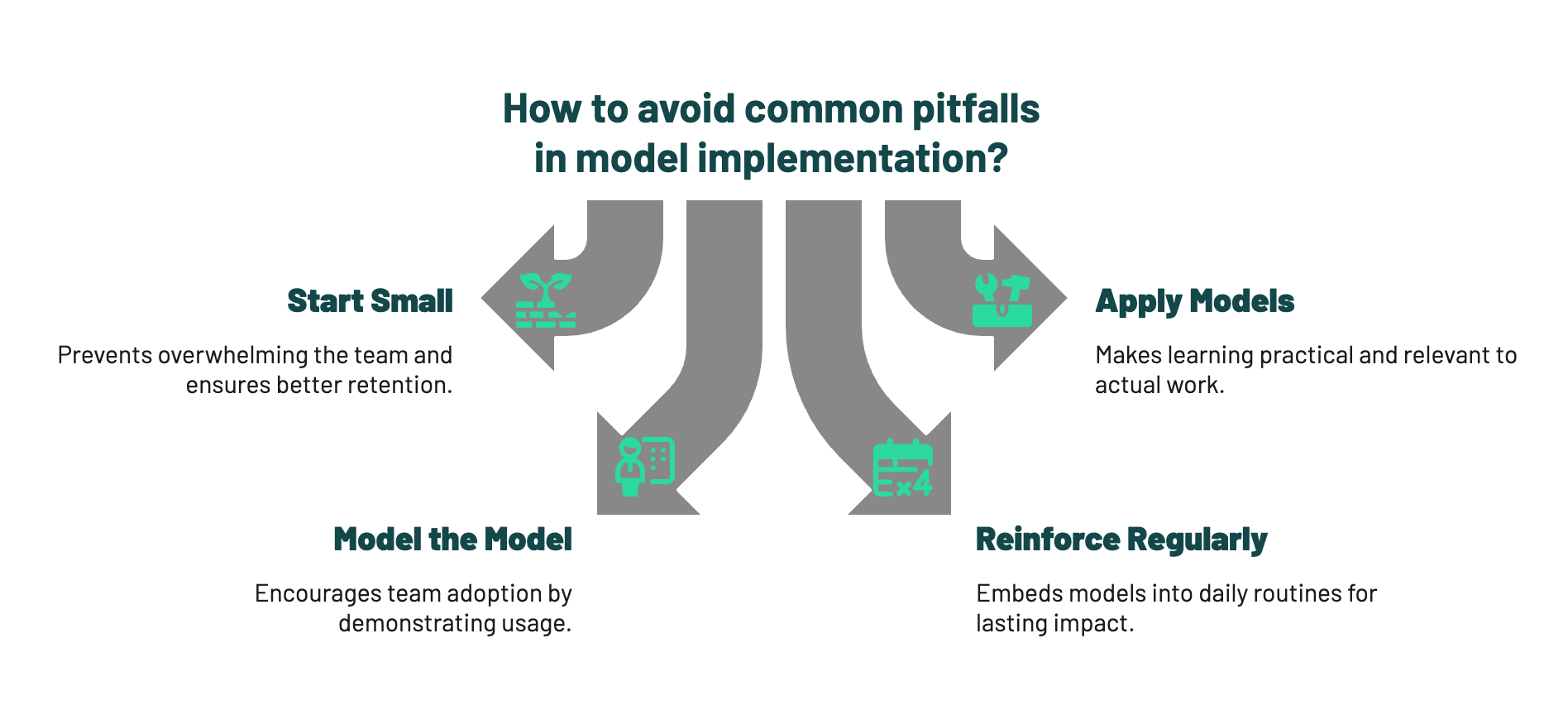
Prompt 1: Which decisions this quarter could benefit from a deliberate model-led review?
Prompt 2: What thinking habits does your team rely on - by default - and which deserve an upgrade?
We’ve seen organisations that integrate 3–5 models into their team routines report:
It’s not about thinking more. It’s about thinking together, better.
And that’s the real multiplier.
Block two hours. Invite your core team. Pick three models. Use a real problem. Reflect together.
Then email us. We’d love to hear what surfaced.
Team SHIFT
What happens when smart individuals work in silos, make decisions on instinct, and confuse alignment with consensus?
Things slow down. Strategies stall. Friction builds under the surface.
We’ve seen it time and again - teams packed with talent still struggle to make clear, confident decisions. Not because they lack capability, but because they lack a shared thinking infrastructure. That’s where mental models come in.
This post is for leaders who want to embed mental models not just into their thinking, but into their team’s culture. The best part? You don’t need an offsite or a three-day retreat. With the right approach, you can run a powerful, engaging workshop in two hours or less.
Let’s walk you through how.

In a world where 70% of strategic failures are traced to execution breakdowns - not flawed vision - the way teams think together becomes a competitive advantage.
Mental models provide scaffolding for sharper decisions and smoother collaboration. As Charlie Munger put it:
“80 or 90 important models will carry about 90% of the freight in making you a worldly-wise person.”
We’ve found that even five to seven models - if consistently used across functions - can radically elevate how teams debate, prioritise, and problem-solve.
We use a 3-part design we call the BAR Method:
Let’s break it down.

Before models can work as mental shorthand, your team needs to know them - deeply enough to spot them in the wild.
Pick 3–5 models that fit your team’s domain. For example:
Activity:
Break the group into pairs. Each pair gets a one-pager with a model explanation and a famous or fictional example (e.g. Apple using First Principles, or Sherlock Holmes using Inversion). Pairs then teach the model back to the group in 2 minutes.
Reflection Prompt: What model here challenges your default approach to decision-making?
Micro-action: Add these models to team wikis or internal playbooks as living tools - not one-time slides.

Models only stick when they solve something you actually care about.
Select a live challenge or recent decision the team made - product launch, market entry, hiring dilemma, pricing change. Then use a model to revisit or reframe it.
Example Scenario:
You’re evaluating two go-to-market plans. Use Second-Order Thinking to forecast not just the immediate outcome, but knock-on effects three steps out.
Facilitation Tip:
Give teams a simple worksheet:
Reflection Prompt: How did this model widen or deepen your original thinking?
Micro-action: Pick one upcoming team meeting where you’ll test-drive a model in real time.

The aha moments often come after the workshop - if you make space for reflection.
Build a closing loop with these two components:
Optional Add-on:
Create a Slack or Teams thread called Mental Model in Action. Encourage people to post examples of when they caught themselves or others using a model.
Reflection Prompt: When did you last wish you'd used a model in hindsight?
Micro-action: Set a recurring 15-minute “Model Monday” slot where one person brings a model to apply to a team issue.

Pro Tip: Run the workshop with cross-functional groups. Diversity of roles reveals the true power of shared frameworks.

Prompt 1: Which decisions this quarter could benefit from a deliberate model-led review?
Prompt 2: What thinking habits does your team rely on - by default - and which deserve an upgrade?
We’ve seen organisations that integrate 3–5 models into their team routines report:
It’s not about thinking more. It’s about thinking together, better.
And that’s the real multiplier.
Block two hours. Invite your core team. Pick three models. Use a real problem. Reflect together.
Then email us. We’d love to hear what surfaced.
Team SHIFT
What happens when smart individuals work in silos, make decisions on instinct, and confuse alignment with consensus?
Things slow down. Strategies stall. Friction builds under the surface.
We’ve seen it time and again - teams packed with talent still struggle to make clear, confident decisions. Not because they lack capability, but because they lack a shared thinking infrastructure. That’s where mental models come in.
This post is for leaders who want to embed mental models not just into their thinking, but into their team’s culture. The best part? You don’t need an offsite or a three-day retreat. With the right approach, you can run a powerful, engaging workshop in two hours or less.
Let’s walk you through how.

In a world where 70% of strategic failures are traced to execution breakdowns - not flawed vision - the way teams think together becomes a competitive advantage.
Mental models provide scaffolding for sharper decisions and smoother collaboration. As Charlie Munger put it:
“80 or 90 important models will carry about 90% of the freight in making you a worldly-wise person.”
We’ve found that even five to seven models - if consistently used across functions - can radically elevate how teams debate, prioritise, and problem-solve.
We use a 3-part design we call the BAR Method:
Let’s break it down.

Before models can work as mental shorthand, your team needs to know them - deeply enough to spot them in the wild.
Pick 3–5 models that fit your team’s domain. For example:
Activity:
Break the group into pairs. Each pair gets a one-pager with a model explanation and a famous or fictional example (e.g. Apple using First Principles, or Sherlock Holmes using Inversion). Pairs then teach the model back to the group in 2 minutes.
Reflection Prompt: What model here challenges your default approach to decision-making?
Micro-action: Add these models to team wikis or internal playbooks as living tools - not one-time slides.

Models only stick when they solve something you actually care about.
Select a live challenge or recent decision the team made - product launch, market entry, hiring dilemma, pricing change. Then use a model to revisit or reframe it.
Example Scenario:
You’re evaluating two go-to-market plans. Use Second-Order Thinking to forecast not just the immediate outcome, but knock-on effects three steps out.
Facilitation Tip:
Give teams a simple worksheet:
Reflection Prompt: How did this model widen or deepen your original thinking?
Micro-action: Pick one upcoming team meeting where you’ll test-drive a model in real time.

The aha moments often come after the workshop - if you make space for reflection.
Build a closing loop with these two components:
Optional Add-on:
Create a Slack or Teams thread called Mental Model in Action. Encourage people to post examples of when they caught themselves or others using a model.
Reflection Prompt: When did you last wish you'd used a model in hindsight?
Micro-action: Set a recurring 15-minute “Model Monday” slot where one person brings a model to apply to a team issue.

Pro Tip: Run the workshop with cross-functional groups. Diversity of roles reveals the true power of shared frameworks.

Prompt 1: Which decisions this quarter could benefit from a deliberate model-led review?
Prompt 2: What thinking habits does your team rely on - by default - and which deserve an upgrade?
We’ve seen organisations that integrate 3–5 models into their team routines report:
It’s not about thinking more. It’s about thinking together, better.
And that’s the real multiplier.
Block two hours. Invite your core team. Pick three models. Use a real problem. Reflect together.
Then email us. We’d love to hear what surfaced.
Team SHIFT
